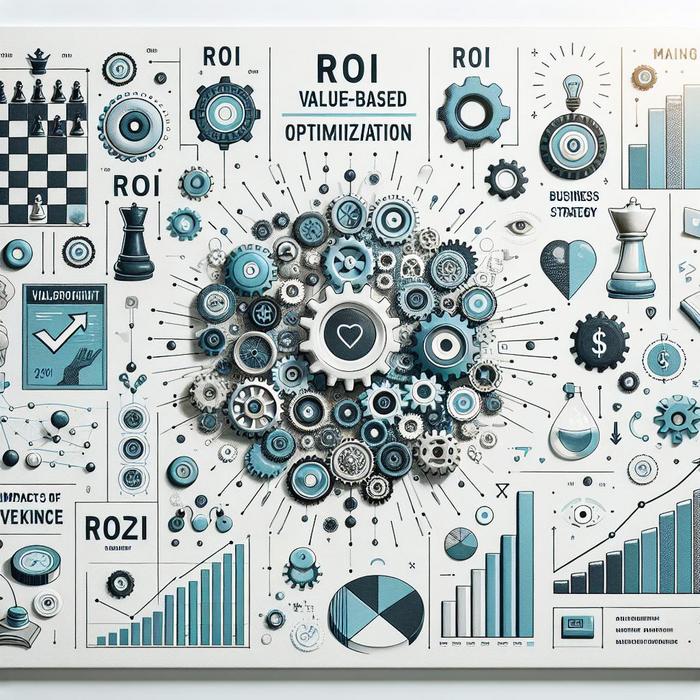Have You Unlocked the Power of Value-Based Optimization?
Picture the scene. It’s the end of a grueling fiscal quarter, and your CFO wants answers about the company’s return on advertising spend (ROAS). While everyone is raving about the sophisticated digital campaigns, something seems missing in the picture – proper ROI. Here’s where Value-Based Optimization enters the scene.
But what’s Value-Based Optimization? It’s a strategic approach to PPC campaigns that aims to optimize for the highest-value conversions rather than just sheer quantity. Unlike traditional bidding strategies, which consider all conversions equal, Value-Based Optimization takes into account the actual revenue contribution of each conversion, potentially leading to significantly higher ROAS (1).
Rediscover ROAS Through Value-Based Optimzation
So, how does Value-Based Optimization contribute to your overall business strategy? It brings back the focus to business growth, maximizing the value extracted from each customer. It offers the potential of driving greater ROI, gained from delivering customer value and earning loyalty. By putting a price tag on your desired conversions, you can see which campaigns and ad groups are driving the most valuable engagements (2).
You’ll discover that it is closely tied with value-based marketing. These two concepts work hand in hand, with value-based marketing focusing on understanding customer needs and desires and Value-Based Optimization ensuring that these insights inform your paid search strategy.
Putting Value-Based Optimization into Practice
So how can you get started with adopting Value-Based Optimization? To fully utilize its potential, it is vital to comprehend customer behavior, their lifetime value, and the profitability of individual leads.
– Leverage Google Ads: Google offers an automated value-based bidding strategy that can help you identify the most valuable customer segments based on their previous shopping behavior (3).
– Analyze Customer Lifetime Value (CLTV): This includes understanding the net profit attributed to the entire future relationship with a customer, helping you identify which customers are likely to contribute the most revenue over an extended period.
Remember, every bit of data matters. Tracking customer behavior and analyzing their preferences will bolster your Value-Based Optimization strategy, leading to a higher ROI (4).
Value-Based Optimization: A Dynamic Shift in PPC Strategy
Amidst these changes, the essence of marketing remains intact – creating and delivering value. With Value-Based Optimization, you can ensure that your PPC campaigns do exactly that.
A research study in the Journal of Business Research suggests that companies applying customer-centric strategies, such as Value-Based Optimization, can improve their financial performance significantly (5).
While the adoption of Value-Based Optimization may seem like a leap, remember that it’s about realizing and harnessing the potential value within your customer base. So, are you ready to infuse new life into your ROI with Value-Based Optimization?
Our next topic will delve deeper into the tactical steps you can take to implement Value-Based Optimization in your business strategy. Stay tuned, and keep leading the change!
Value-Based Optimization: The New Terrain for CMOs, CGOs, and CFOs
For chief officers at the top executive level, there’s been notable progress in understanding and identifying high-value customers. This progression is a product of complex data analyses on customer behavior patterns and innovation in tracking systems to follow these patterns. Indeed, Value-Based Optimization is setting a new terrain for CMOs, CGOs, and CFOs, precipitating strategic decisions leading to growth.
Significant strides have been made in integrating customer value and PPC campaigns. Value-Based Optimization finds and targets high-value shopper segments, allowing proper resource allocation towards these segments. This approach necessitates deep insight into customer needs and behaviors, fostering valuable relationships that translate into increased ROAS.
Innovation in Value-Based Optimization Tools
Where the difference between success and mediocrity lies in the fine-tuning of marketing strategies, technological advancements have come to the rescue. With modern Value-Based Optimization tools, companies can analyze thousands of data points in real-time, allowing them to zero in on patterns that represent high-value shoppers (6).
For example, innovative AI-driven algorithms can shorten the path to gaining insight into shopper behavior by analyzing real-time interactions, engagement patterns, and purchases. With these tools, Value-Based Optimization becomes a streamlined, automated process that boosts ROAS and propels businesses towards their revenue targets.
Making The Most of Value-Based Optimization
It is increasingly clear that strategic success hinges profoundly on the ability to differentiate customer values and integrate these insights into marketing strategy. So, how can top executives ensure they are making the most of Value-Based Optimization? A couple of strategies come to mind:
– Dive into customer behavior: Customers are more than numbers on a spreadsheet. They are complex individuals with distinct consumption patterns. Therefore, executives need to engage user-friendly marketing platforms that can analyze, link, and attribute data from various customer touchpoints (7).
– Use a proactive outlook: Keep up with industry trends. Be at the forefront of adopting new and improved data analysis tools that optimize advertising campaign value (8).
The Role of Leadership in Value-Based Optimization Adoption
The movement towards Value-Based Optimization adoption, like any other systemic transformation, requires strong and visionary leadership. Organizational leaders must promote and encourage the use of Value-Based Optimization strategies across all relevant departments. Given its role in enhancing ROAS, it is essential that the benefits and implementation of Value-Based Optimization are clearly communicated across the organization.
Top-management executives, particularly CMOs and CFOs, can foster a culture of data-driven decision-making. By nurturing this mindset, they can leverage the full potential of Value-Based Optimization, creating a competitive advantage that is much needed.
Understanding and implementing Value-Based Optimization does demand a fair measure of diligence and a healthy appetite for knowledge, but its benefits cannot be overstated. Where data is the new oil, the adoption of Value-Based Optimization can indeed create a significant difference in the ROAS, leading to sustainable growth and profitability.
In the next piece, we will speak about the role and importance of team efforts in Value-Based Optimization adoption, guiding you through the paradigm shift that this innovative strategy brings. Join us in this endeavor, and let’s redefine ROAS together.

